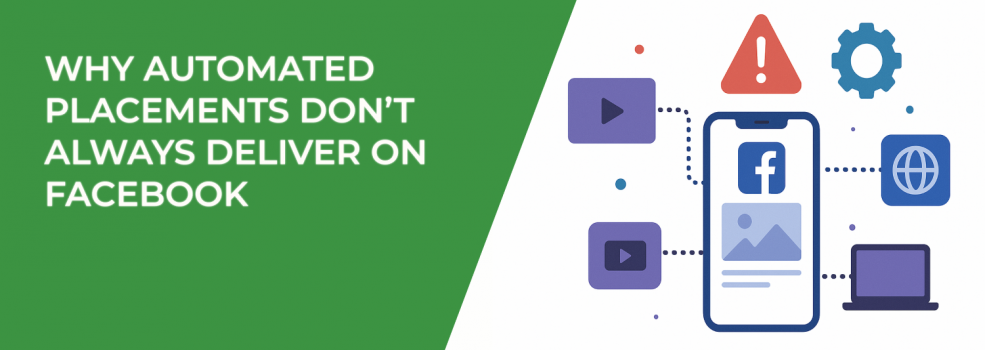When you run Facebook ads, you’ll often see the platform suggest using Automated Placements. The idea is simple: let Facebook show your ads in different spots across Facebook, Instagram, Messenger, and the Audience Network. The algorithm then tries to place your ads where it thinks you’ll get the lowest cost per result.
That can sound like a smart shortcut. But here’s the truth — while Automated Placements can save time and expand your reach, they don’t always bring in the results you’re really looking for. Sometimes they end up wasting your budget on cheap clicks that don’t turn into sales or leads.
If you’ve ever wondered why your ads are showing in the wrong places or not converting, this article will help you understand what’s going on and how to fix it.
The Problem With “Lowest Cost”
Facebook’s system is built to find the cheapest way to reach your goal. That works fine if your goal is something broad, like impressions or clicks. But if you care about leads, purchases, or high-quality engagement, “cheap” often means “low quality.”
Think about it. A click from the Audience Network (ads that appear in apps or on other websites) might cost less than a click from the Facebook News Feed. But how many of those app users are actually interested in buying what you’re offering? Many times, those clicks are accidental or irrelevant.
This is one of the reasons campaigns sometimes stall during the learning phase. If you’re struggling there too, check out How to Finish the Facebook Learning Phase Quickly.
Pros and Cons of Automated Placements
To decide whether Automated Placements make sense for your campaigns, it helps to look at both sides.
Here are the main benefits you can get:
-
Wider reach — Your ads are shown across more platforms and surfaces without you needing to set them manually.
-
Lower cost per click or impression — Facebook usually finds cheaper placements, which can reduce your overall ad costs.
-
Easy setup — It saves time because you don’t have to pick placements yourself.
-
Chance to find hidden opportunities — Sometimes, placements you wouldn’t expect, like Instagram Reels, perform surprisingly well.
That all sounds good. But there are downsides to keep in mind:
-
Quality can drop — Cheap clicks from certain placements may not lead to real conversions.
-
Less control over budget — You don’t get to focus spending on the placements that matter most to you.
-
Ads may not fit every placement — A video that looks great in the News Feed might not work in Stories.
-
Risk of wasted impressions — Some placements show your ads a lot, but the audience there might not take action.
If you want to understand how placement choices really impact results, I recommend reading Why Ad Placement Choices Can Make or Break Your Facebook Campaign.
Placement Quality Really Matters
Not all placements are equal. Some create stronger intent and better engagement, while others bring weak results. If you want to avoid wasting money, you need to understand the differences.
Here’s a quick breakdown of common placements:
-
Facebook News Feed — High visibility and strong engagement, usually one of the best performers.
-
Instagram Stories and Reels — Great for fast, visual ads, but users swipe quickly, so your message needs to grab attention.
-
Audience Network — Very cheap, but often low quality, with lots of accidental clicks.
-
Messenger Ads — Good for direct, conversational campaigns, but more limited in reach.
-
Right Column Ads — Affordable, but easy to overlook because of small size and desktop-only visibility.
If you want a full deep dive into formats, take a look at The Ultimate Guide to Facebook Ad Formats.
How to Spot Engagement Gaps
Have you ever seen your ad reports show thousands of impressions but no real increase in conversions? That’s a common sign of Automated Placements pushing your ads into low-quality spots.
The best way to check is simple:
-
Go into Ads Manager and break down results by placement.
-
Compare the cost per conversion, not just cost per click.
-
Look for placements that get clicks but don’t bring actual leads or sales.
If your ads still aren’t converting even after cleanup, you’ll want to review targeting and creative. This guide can help: Facebook Ads Not Converting: How To Fix It.
How to Use Automated Placements the Smart Way
Automated Placements aren’t all bad. In fact, they can be useful if you treat them as a way to test where your ads perform best. The key is not to leave them running without checking in.
Here are some simple tips to make them work better:
-
Start broad, then refine. Let Facebook test placements at the beginning, but cut the weak ones after a few days.
-
Make ads fit the placement. Create different versions of your ad for Stories, Reels, and Feeds so they look natural in each format.
-
Turn off poor placements quickly. If Audience Network or another placement isn’t working, don’t let it drain your budget.
-
Check performance every week. Regular check-ins help you make adjustments before too much money is wasted.
This balance of testing and refining is what separates strong campaigns from weak ones.
Should You Use Automated Placements?
The answer really depends on your goals. If you just want reach and exposure, then Automated Placements can work well. But if your main goal is conversions, sales, or high-quality leads, you’ll likely want to step in and manage placements more closely.
It comes down to this: do you want Facebook to decide where your ads show, or do you want to make sure your budget is spent only in the places that bring results?
Final Thoughts
Automated Placements on Facebook can save time and sometimes lower costs, but they don’t always deliver the outcomes that matter most. Without regular monitoring, they often favor cheap clicks over meaningful conversions.
The best approach is balance. Use Automated Placements to test at first, then analyze the data and take back control. That way, you protect your budget, improve your ad performance, and make sure your campaigns actually support your business goals.

